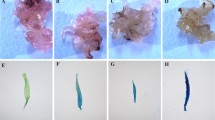Abstract
Cold tolerance of field grown plants and shoot cultures of a commercial sugarbeet cultivar, ‘Hilma’, was compared with that of two cultivars bred for improved cold tolerance, ‘Monofeb’ and ‘Winter Hybrid 88619’. Leaves of ‘Monofeb’ and ‘Winter Hybrid 88619’ showed an increase in frost tolerance compared to Hilma, as assessed by electrolyte leakage measurements, in both July, and November. However, all varieties exhibited acclimation in the latter month. Similar qualitative differences between cultivars were detected in shoot cultures only when maintained on low (1%) sucrose medium, without added plant growth regulators. The use of high (3%) sucrose and benzyladenine, which releases apical dominance producing multiple shoots, each contributed to a substantial lowering of the temperature at which cold-induced damage occurred in leaves. Under these conditions varietal differences were masked. The implications of these findings in regard to in vitro selection for improved cold tolerance in organized cultures are discussed.
Similar content being viewed by others
Abbreviations
- BA:
-
benzyladenine
- MS:
-
Murashige & Skoog (1962)
References
Atanassov AI (1986) Sugarbeet. In: Evans DA, Sharp WR & Ammirato PV (Eds) Handbook of Plant Cell Culture, Vol 4 (pp 652–680). Macmillan, New York
Bannier LJ & Steponkus PL (1976) Cold acclimation ofChrysanthemum callus cultures. J. Amer. Soc. Hort. Sci. 101: 409–412
Collin HA & Dix PJ (1990) Culture Systems and Selection Procedures. In: Dix PJ (Ed) Plant Cell Line Selection (pp 3–18). VCH Publishers, Weinheim
DeGreef W & Jacobs M (1979) In vitro culture of sugarbeet: Description of a cell line with high regeneration capacity. Plant Sci. Lett. 17: 55–61
Dix PJ & Street HE (1976) Selection of plant cell lines with enhanced drilling resistance. Ann. Bot. 40: 903–910
Duda V & Kacperska A (1983) Frost tolerance estimation in callus derived from poplar and winter rape using three different methods. Z. Pflanzenphysiol. 111: 69–73
Horsch RB, Fry JE, Hoffman NL, Eichholz D, Rogers SG & Fraley RT (1985) A simple method for transferring genes into plants. Science 277: 1221–1231
Lindsey K & Gallois P (1990) Transformation of sugarbeet (Beta vulgaris) byAgrobacterium tumefaciens. J. Exp. Bot. 41: 529–536
Lindsey K & Jones MGK (1990) Selection of transformed cells In: Dix PJ (Ed) Plant Cell Line Selection (pp 317–339) VCH Publishers. Weinheim
Malone RP & PJ (1990) Mutagenesis and triazine herbicide effects in strawberry shoot cultures. J. Exp. Bot 225: 463–469
McCabe PF, Timmons AM & Dix PJ (1989) A simple procedure for the isolation of streptomycin-resistant plants in Solanaceae. Mol. Gen. Genet. 216: 132–137
Murashige T & Skoog F (1962) A revised medium for the rapid growth and bioassays with tobacco tissue cultures. Physiol. Plant 15: 473–497
O'Connor L & Fitzgerald P (1987) Out-of-season sugar beet-searching for bolting-resistant varieties. Farm and Food Research 18: 27–29
Pearce RS & McDonald I (1977) Ultrastructural damage due to freezing followed by thawing in shoot meristem and leaf cells of tall fescue (Festuca arundinacea). Planta 134: 189–198
Pearce RS & McDonald I (1978) An independent assessment of frost hardiness of excised laminae, excised roots and trimmed tillers of tall fescue (Festuca arundinacea). J. Appl. Ecol. 15: 885–895
Ritchie GA, Short KC & Davey MR (1989) In vitro shoot regeneration from callus, leaf axils and petioles of sugar beet (Beta vulgaris L.) J. Exp. Bot. 40: 277–283
Saunders JW (1982) A flexible in vitro shoot culture propagation system for sugarbeet that includes rapid floral induction of ramets. Crop Sci. 22: 1102–1105
Sullivan CP, Finch I, Dix PJ & Burke JI (1993) In vitro propagation systems in sugarbeet. Ir. J. Agtric. Food Res. 32: 27–35
Tétu T, Sangwan RS & Sangwan-Norreel BS (1987) Hormonal control of organogenesis and somatic embryogenesis inBeta vulgaris callus. J. Exp. Bot. 38: 506–517
Van Swaajj AC, Jacobsen EJ, Feenstra WJ (1985) Effect of cold hardening, wilting and exogenously applied proline on leaf proline content and frost tolerance of several genotypes ofSolanum. Physiol. Plant 64: 230–236
Author information
Authors and Affiliations
Rights and permissions
About this article
Cite this article
Dix, P.J., Finch, I. & Burke, J.I. Genotypic differences in cold tolerance are masked by high sucrose and cytokinin in shoot cultures of sugarbeet. Plant Cell Tiss Organ Cult 36, 285–290 (1994). https://doi.org/10.1007/BF00046085
Received:
Accepted:
Issue Date:
DOI: https://doi.org/10.1007/BF00046085



